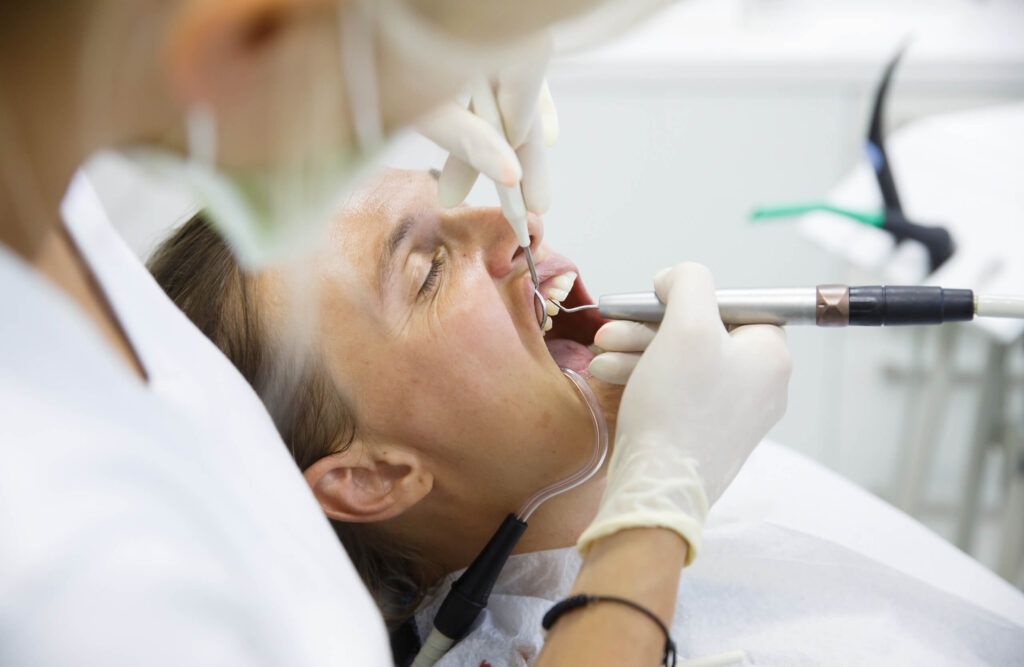Scaling & Root Planing
The initial stage of treatment for periodontal disease is usually a thorough cleaning that may include scaling and root planning with local anesthesia. The objective of this non-surgical approach is to remove dental plaque and tartar, or calculus, which cause gum inflammation and disease.
- Scaling is performed to remove calculus and plaque that attaches to the tooth surfaces. The process especially targets the area below the gum line, along the root. Scaling is performed with a special dental tool called an ultrasonic scaling tool. The scaling tool usually includes an irrigation process that can be used to deliver an antimicrobial agent below the gums to help reduce oral bacteria.
- Root Planing is performed to remove infected cementum and surface dentin from the tooth surface that is embedded with unwanted microorganisms, toxins and tartar. The root of the tooth is literally smoothed, which promotes healing, and helps prevent bacteria from easily recolonizing in the future.
- Scaling and root planing can be used as a stand-alone treatment, or a preventative measure. It is commonly performed on cases of gingivitis and moderate to severe periodontal disease.
Benefits of Treatment
If treatment is successful, scaling and planing may have many periodontal benefits. One is that it can help prevent disease. Research has proven that bacteria from periodontal infections can travel through the blood stream and affect other areas of the body, sometimes causing heart and respiratory diseases. Scaling and root planing removes bacteria that causes these conditions.
Another benefit of treatment is protecting against tooth loss. When gum pockets exceed 3mm in depth, the risk for periodontal disease increases. As pockets deepen, more bacteria can colonize, eventually causing a chronic inflammatory response by the body to destroy gum and bone tissue. This leads to tooth loss.

Dr. Bramanti is very conservative in periodontal treatment recommendations and limits surgery to the areas where it is absolutely necessary. Many times, the early stages of periodontal disease are best treated with non-surgical periodontal therapy. Even in severe cases, non-surgical periodontal therapy often precedes most needs for surgical therapy. This is done to improve the overall tissue quality prior to surgery and to help limit the areas requiring surgery.
Finally, scaling and root planing may make the mouth more aesthetically pleasing and should reduce bad breath caused from food particles and bacteria in the oral cavity. Superficial stains on the teeth will be removed during scaling and root planing, adding an extra bonus to the procedures.
When deep pockets between teeth and gums are present, it is difficult for the doctors to thoroughly remove plaque and tartar. Patients can seldom, if ever, keep these pockets clean and free of plaque. Consequently, surgery may be considered to bring back complete periodontal health.
Bite Adjustment
A bite is considered to be healthy when all or most of the teeth are present and not destroyed by normal daily usage. The bite is destructive when teeth show wear, looseness or when TMJ (jaw joint) damage is seen.
Bite therapy helps restore a bite that can function without damage and destruction. The therapy may include:
- Bite splint therapy using a custom-fitted and adjusted orthopedic appliance to keep the teeth apart, day, night, or both.
- Orthopedic appliance bite therapy also promotes the healing of the TMJs, calms the storm of hyperactive muscles and improves posture.
- Reshaping the biting surfaces of the teeth and eliminating spots of excessive pressures where the teeth are brought into contact. This is done by carefully dividing bite pressures evenly across all the teeth.
- Braces to reposition misaligned or drifted teeth.
- Replacement of old, worn out, or damaged fillings.
- Reconstruction of badly worn and damaged teeth.
Dr. Bramanti is very conservative in periodontal treatment recommendations and limits surgery to the areas where it is absolutely necessary. Many times, the early stages of periodontal disease are best treated with non-surgical periodontal therapy. Even in severe cases, non-surgical periodontal therapy often precedes most needs for surgical therapy. This is done to improve the overall tissue quality prior to surgery and to help limit the areas requiring surgery.
Scaling & Root Planing
The initial stage of treatment for periodontal disease is usually a thorough cleaning that may include scaling and root planning with local anesthesia. The objective of this non-surgical approach is to remove dental plaque and tartar, or calculus, which cause gum inflammation and disease.
- Scaling is performed to removecalculus and plaque that attaches to the tooth surfaces. The process especially targets the area below the gum line, along the root. Scaling is performed with a special dental tool called an ultrasonic scaling tool. The scaling tool usually includes an irrigation process that can be used to deliver an antimicrobial agent below the gums to help reduce oral bacteria.
- Root Planing is performed to remove infected cementum and surface dentin from the tooth surface that is embedded with unwanted microorganisms, toxins and tartar. The root of the tooth is literally smoothed, which promotes healing, and helps prevent bacteria from easily recolonizing in the future.
- Scaling and root planing can be used as a stand-alone treatment, or a preventative measure. It is commonly performed on cases of gingivitis and moderate to severe periodontal disease.
Benefits of Treatment
If treatment is successful, scaling and planing may have many periodontal benefits. One is that it can help prevent disease. Research has proven that bacteria from periodontal infections can travel through the blood stream and affect other areas of the body, sometimes causing heart and respiratory diseases. Scaling and root planing removes bacteria that causes these conditions.
Another benefit of treatment is protecting against tooth loss. When gum pockets exceed 3mm in depth, the risk for periodontal disease increases. As pockets deepen, more bacteria can colonize, eventually causing a chronic inflammatory response by the body to destroy gum and bone tissue. This leads to tooth loss.
Finally, scaling and root planing may make the mouth more aesthetically pleasing and should reduce bad breath caused from food particles and bacteria in the oral cavity. Superficial stains on the teeth will be removed during scaling and root planing, adding an extra bonus to the procedures.
When deep pockets between teeth and gums are present, it is difficult for the doctors to thoroughly remove plaque and tartar. Patients can seldom, if ever, keep these pockets clean and free of plaque. Consequently, surgery may be considered to bring back complete periodontal health.
Bite Adjustment
A bite is considered to be healthy when all or most of the teeth are present and not destroyed by normal daily usage. The bite is destructive when teeth show wear, looseness or when TMJ (jaw joint) damage is seen.
Bite therapy helps restore a bite that can function without damage and destruction. The therapy may include:
- Bite splint therapy using a custom-fitted and adjusted orthopedic appliance to keep the teeth apart, day, night, or both.
- Orthopedic appliance bite therapy also promotes the healing of the TMJs, calms the storm of hyperactive muscles and improves posture.
- Reshaping the biting surfaces of the teeth and eliminating spots of excessive pressures where the teeth are brought into contact. This is done by carefully dividing bite pressures evenly across all the teeth.
- Braces to reposition misaligned or drifted teeth.
- Replacement of old, worn out, or damaged fillings.
- Reconstruction of badly worn and damaged teeth.
